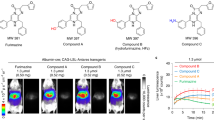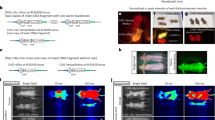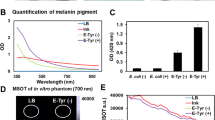Abstract
The bacterial lacZ gene encoding for β-galactosidase (β-gal) is a common reporter gene used in transgenic mice. Nonetheless, the absence of fluorigenic substrates usable in live animals greatly hampered the non-invasive follow-up of this reporter gene expression. We used far-red fluorescence for imaging β-Gal expression in live cells in vitro or in vivo. The 9H-(1,3-dichloro-9,9-dimethylacridin- 2-one-7-yl) β-D-galactopyranoside substrate was used to monitor β-Gal expression as a reporter of tumor growth, or of the physiological levels of an endogenous gene or of gene transfer in lung. A quantitative evaluation of this method as well as a comparison of its sensitivity with Firefly Luciferase-based bioluminescence was also performed. In vivo measurements showed that 103 β-Gal tumor cells located under the skin were detectable. In deeper organs like lung, as little as 5 ng of β-Gal or Luciferase enzymes per mg of proteins were measured, confirming that both techniques reached similar sensibilities. Nonetheless, quantitative comparison of β-Gal levels measured with far-red imaging or with a standardized enzymatic evaluation after killing revealed that the 2D-fluorescent reflectance imaging method is submitted to a color-dependent disparity of the organs and cannot supply quantitative measurements but that a simple correction can be applied.
This is a preview of subscription content, access via your institution
Access options
Subscribe to this journal
Receive 12 print issues and online access
$259.00 per year
only $21.58 per issue
Buy this article
- Purchase on Springer Link
- Instant access to full article PDF
Prices may be subject to local taxes which are calculated during checkout




Similar content being viewed by others
References
Schenborn E, Groskreutz D . Reporter gene vectors and assays. Mol Biotechnol 1999; 13: 29–44.
Bogdanov AAJ, Weissleder R . In vivo imaging of gene delivery and expression. Trends Biotechnol 2002; 8: S11–S18.
Contag CH, Bachmann MH . Advances in in vivo bioluminescence imaging of gene expression. Annu Rev Biomed Eng 2002; 4: 235–260.
Liang Q, Nguyen K, Satyamurthy N, Barrio JR, Phelps ME, Gambhir SS et al. Monitoring adenoviral DNA delivery, using a mutant herpes simplex virus type 1 thymidine kinase gene as a PET reporter gene. Gene Therapy 2002; 9: 1659–1666.
Berger F, Gambhir SS . Recent advances in imaging endogenous or transferred gene expression utilizing radionuclide technologies in living subjects: applications to breast cancer. Breast Cancer Res 2001; 3: 28–35.
Hoffman R . Green fluorescent protein imaging of tumour growth, metastasis, and angiogenesis in mouse models. Lancet Oncol 2002; 3: 546–556.
Weissleder R . Scaling down imaging: molecular mapping of cancer in mice. Nat Rev Cancer 2002; 2: 11–18.
Sanes JR, Rubenstein JL, Nicolas JF . Use of a recombinant retrovirus to study post-implantation cell lineage in mouse embryos. EMBO J 1986; 5: 3133–3142.
James AL, Perry JD, Chilvers K, Robson IS, Armstrong L, Orr KE . Alizarin-beta-D-galactoside: a new substrate for the detection of bacterial beta-galactosidase. Lett Appl Microbiol 2000; 30: 336–340.
Rakhmanova VA, MacDonald RC . A microplate fluorimetric assay for transfection of the beta-galactosidase reporter gene. Anal Biochem 1998; 257: 234–237.
Young DC, Kingsley SD, Ryan KA, Dutko FJ . Selective inactivation of eukaryotic beta-galactosidase in assays for inhibitors of HIV-1 TAT using bacterial beta-galactosidase as a reporter enzyme. Anal Biochem 1993; 215: 24–30.
Chilvers KF, Perry JD, James AL, Reed RH . Synthesis and evaluation of novel fluorogenic substrates for the detection of bacterial beta-galactosidase. J Appl Microbiol 2001; 91: 1118–1130.
Gee KR, Sun WC, Bhalgat MK, Upson RH, Klaubert DH, Latham KA et al. Fluorogenic substrates based on fluorinated umbelliferones for continuous assays of phosphatases and beta-galactosidases. Anal Biochem 1999; 273: 41–48.
Louie AY, Huber MM, Ahrens ET, Rothbächer U, Moats R, Jacobs RE et al. In vivo visualization of gene expression using magnetic resonance imaging. Nat Biotechnol 2000; 18: 321–325.
Lee KH, Byun SS, Choi JH, Paik JY, Choe YS, Kim BT . Targeting of lacZ reporter gene expression with radioiodine-labelled phenylethyl-beta-d-thiogalactopyranoside. Eur J Nucl Med Mol Imaging 2004; 31: 433–438.
Tung CH, Zeng Q, Shah K, Kim DE, Schellingerhout D, Weissleder R . In vivo imaging of beta-galactosidase activity using far red fluorescent switch. Cancer Res 2004; 64: 1579–1583.
Weissleder R, Ntziachristos V . Shedding light onto live molecular targets. Nat Med 2003; 9: 123–128.
Brown EB, Campbell RB, Tsnzuki Y, Xu L, Carmeliet P, Fukumura D et al. In vivo measurement of gene expression, angiogenesis and physiological function in tumors using multiphoton laser scanning microscopy. Nat Med 2001; 7: 864–868.
Corey PF, Trimmer RW, Biddlecom WG . A new chromogenic b-galactosidase substrates: 7-D-galactopyranosyloxy-9,9-dimethyl-9H-acridin- 2-one. Angew Chem Int Ed Engl 1991; 30: 1646–1648.
Chollet P, Favrot MC, Hurbin A, Coll JL . Side-effects of a systemic injection of linear polyethylenimine–DNA complexes. J Gene Med 2002; 4: 84–91.
Prandini MH, Dreher I, Bouillot S, Benkerri S, Moll T, Huber P . The human VE-cadherin promoter is subjected to organ-specific regulation and is activated in tumour angiogenesis. Oncogene 2005; 24: 2992–3001.
Jenkins DE, Hornig YS, Oei Y, Dusich J, Purchio T . Bioluminescent human breast cancer cell lines that permit rapid and sensitive in vivo detection of mammary tumors and multiple metastases in immune deficient mice. Breast Cancer Res 2005; 7: R444–R454.
Goula D, Benoist C, Mantero S, Merlo G, Levi G, Demeneix BA . Polyethylenimine-based intravenous delivery of transgenes to mouse lung. Gene Therapy 1998; 5: 1291–1295.
Coll JL, Chollet P, Brambilla E, Desplanques D, Behr JP, Favrot M . In vivo delivery to tumors of DNA complexed with linear polyethylenimine. Hum Gene Ther 1999; 10: 1659–1666.
Zou SM, Erbacher P, Remy JS, Behr JP . Systemic linear polyethylenimine (L-PEI)-mediated gene delivery in the mouse. J Gene Med 2000; 2: 128–134.
Ntziachristos V, Tung CH, Bremer C, Weissleder R . Fluorescence molecular tomography resolves protease activity in vivo. Nat Med 2002; 8: 757–760.
Garanger E, Boturyn D, Jin Z, Dumy P, Favrot MC, Coll JL . New multifunctional molecular conjugate vector for targeting, imaging, and therapy of tumors. Mol Ther 2005; 12: 1168–1175.
Jin ZH, Josserand V, Razkin J, Garanger E, Boturyn D, Favrot MC et al. Noninvasive optical imaging of ovarian metastases using Cy5-labeled RAFT-c(-RGDfK-)4. Mol Imaging 2006; 5: 188–197.
Acknowledgements
This work was supported by the Institut National de la Sante Et de la Recherche Medicale (INSERM), the programme Interdisciplinaire 2001–2004 ‘Imagerie du Petit Animal’, the Canceropole Lyon-Alpes Rhone-alpes (CLARA), the Association for Research on Cancer (ARC), the Agence Nationale pour la Recherche (ANR) and the EMIL and N2L NoEs of the 6th framework. We are also grateful to Philippe Rizo (CEA Leti, France) for offering optical imaging system and to Dr Anne Imberty for useful discussion. We thank Corine Tenaud, Mélanie Guidetti and Dominique Desplanques in our laboratory for technical assistance.
Author information
Authors and Affiliations
Corresponding author
Rights and permissions
About this article
Cite this article
Josserand, V., Texier-Nogues, I., Huber, P. et al. Non-invasive in vivo optical imaging of the lacZ and luc gene expression in mice. Gene Ther 14, 1587–1593 (2007). https://doi.org/10.1038/sj.gt.3303028
Received:
Revised:
Accepted:
Published:
Issue Date:
DOI: https://doi.org/10.1038/sj.gt.3303028
Keywords
This article is cited by
-
A lacZ Reporter-Based Strategy for Rapid Expression Analysis and Target Validation of Mycobacterium tuberculosis Latent Infection Genes
Current Microbiology (2016)
-
The dual effect of mesenchymal stem cells on tumour growth and tumour angiogenesis
Stem Cell Research & Therapy (2013)
-
Enhanced tumor therapy using vaccinia virus strain GLV-1h68 in combination with a β-galactosidase-activatable prodrug seco-analog of duocarmycin SA
Cancer Gene Therapy (2011)
-
Imaging stem-cell-driven regeneration in mammals
Nature (2008)
-
Whole Animal In Vivo Imaging After Transient, Nonviral Gene delivery to the Rat Central Nervous System
Molecular Therapy (2008)



